Chapter 2.
IMPERATOR ANDRONICUS KOMNIN OF THE XII CENTURY - IT IS JESUS CHRIST DURING HIS PRESENCE IN TSAR-GRAD OF THE XII CENTURY.
10. MIRACLES OF ANDRONICUS AND MIRACLES OF CHRIST.
The Gospels speak a lot of the miracles performed by Christ. It turns out that Emperor Andronicus also performed miracles. We learn it from Nicetas Choniates, though he considered those miracles ‘wrong’ and accredits them to Andronicus’ exceptional cunning and intelligence. For example Andronicus ‘went through walls’. To remind you, Christ also penetrated walls. In the Gospel printed in Moscow in 1651 it is said:
"И по днех осмих, паки бяху внутрь ученицы Его, и Фома с ними. Прииде IС (Исус - Авт.), дверемзатвореном, и ста посреди их, и рече мир вам" [144], Иоанн, зачало 65."
Meaning: ’After eight days again His disciples gathered together inside and Thomas with them. Jesus came in through the closed doors and stood amongst them and said: ‘Peace be with you’. ‘We should like to note that the modern synodical translation glosses over this place, though the meaning stays the same. We cite: ‘After eight days His disciples were again inside, and Thomas with them. Jesus came, the doors having been shut, and stood in their midst and said, "Peace be with you.’ (John 20:26)
Nicetas Choniates dedicates a rather long narration to an analogous fable from the story of Andronicus. We will not give it here in full, but will give its essence. Andronicus was put into a dungeon ‘in the strongest insuperable iron shackles… But as he was a brave man, extremely cunning and rather resourceful under the difficult circumstances, then having discovered in his dungeon… an old underground pass he used his hands as a broom and a shovel digging out a hole in it for entering and exiting so it was hidden and then covered it with some household items and hid himself in it. At dinner time the guards unlocked the dungeon doors and brought the usual food, but they could not find their dinner guest anywhere. They started inspecting it to see if the dungeon was broken up in or dug through somewhere and if the cunning Andronicus has escaped. But there was no damage anywhere: NEITHER THE DOOR BRACKETS, NOR THE DOOR FRAME, NOR THE DOORSTEP, NOR THE CEILING, NOR THE REAR OF THE BUILDING, NOR THE IRON BARS ON THE WINDOWS - in short, nothing was damaged. Then the guards started yelling and scratching their faces with their nails, because they had lost the prisoner they were guarding [140], p.117-118.
Then Nicetas Choniates described as Andronicus’ wife was thrown into the same dungeon. Andronicus suddenly appeared before her and frightened her terribly, as is wife mistook him for a shadow from the kingdom of the dead [140], p.118. Naturally Choniates’ text is more recent and heavily edited, embroidered with the XVII-XVIII cc. fiction, but through this text the contours of the old original appear. In which it probably said that Christ having gone through the walls suddenly appeared in front of the disciples or Mary Magdalene.
Further on the Gospels speak a lot of Christ’s resurrection. Presumably something of the kind was in the text which was edited by ‘Nicetas Choniates’. He informs us, that Andronicus having entered Czar-Grad, went to the tomb of King Manuel, beside which he was making some strange gestures and pronouncing some mysterious incantations in a barbaric language. We cite: ‘When… they wanted to take him away from the grave and told him that he had cried enough, he … urged to be left at the tomb for a little longer as he had something he had to tell the deceased in private. Putting his hands together as if in prayer with his palms stretched outwards, Andronicus raised his eyes towards the stone tomb and moving his lips soundlessly to bystanders, murmured something in secret. Most took this whispering for some kind of barbaric mantra’ [140], p.270.
Such chanting by the coffin and the direct communicating with the deceased is far from being a normal thing in the Byzantine emperors’ everyday life. At least nothing of the kind was ever said about any other emperor. It seems to us, that this more recent account is the result of some gospel accounts describing the resurrection miracles performed by Christ. Nicetas Choniates when re-writing the old chronicles naturally omits mention of the miracle itself, as he does not consider Andronicus to be a god or a man, who possesses the miracle-working powers. But the clear trace remained.
11. ANDRONICUS’ REMARKABLE INTELLIGENCE.
Despite his apparent and undisguised dislike towards Andronicus, Nicetas Choniates constantly underlines Andronicus’ remarkable intelligence and his ‘amazing cunning’. Choniates writes about it in many places. Here is just one of the citations: ‘There were many machinations plotted against Andronicus both secretly and openly; but he destroyed them like meshes of cobweb and dispersed them like child’s play due to his courage and intelligence, which was as much above his enemies as the dumb animals are beneath intelligent humans’ [140], p.116.
Besides, Andronicus could write eloquently and persuasively. Nichetas Choniates straight forwardly calls him a philosopher. We are told: ‘(Andronicus – Author) loved utterly the Epistles of Paul, enjoyed the delight they exuded and loved to insert their irresistibly powerful aphorisms IN HIS BEAUTIFUL LETTERS’ [140], p.360. Here we see an attempt of a more recent editor, hiding under the name of ‘Nicetas Choniates’, to explain the obvious evangelical sense of Andronicus’ epistles by the fact that he copied a lot from Paul the Apostle. Besides, Andronicus allegedly not only wrote with Paul the Apostle’s words, but also spoke with his words [140], p.343.
Nicetas Choniates informs us that Andronicus studied philosophy and theology in particular. Moreover he issued some kind of rules in this regard, i.e. he issued the commandments. We cite: ‘He highly disapproved of a custom, common then and now, to debate the divine dogmata and by no means liked to say or listen to anything new about God, though he was not at all unfamiliar to our wisdom… He valued education and did not remove from himself learned people, but on the contrary brought them close to his throne and often encouraged them with gifts and honoured them with important dignities. He also considered celestial philosophy to be important and highly valued, approved of the eloquent orators and held in high esteem the skilful legal scholars’ [140], p.339-340.
Indeed, in the Gospels Christ appears to be a philosopher. He gives the commandments, changes the laws of Moses, answers the questions about how one should and should not behave in certain situations. He takes part in trials. For example, recall the trial of a sinner, when Christ virtually presides over a trial. ‘At dawn he appeared again in the temple courts, where all the people gathered around him, and he sat down to teach them. The teachers of the law and the Pharisees brought in a woman caught in adultery’ (John 8:1-11). Jesus delivers the famous judgement: ‘Let any one of you who is without sin be the first to throw a stone at her (John 8:7). Andronicus also presided over trials.
No other Byzantine emperor was described as a philosopher on the throne, superior in intelligence to such extent as Andronicus did. At the same time it corresponds brilliantly with the Gospel description, where Christ is by far superior to the others in intelligence. In particular, still in his childhood when having a conversation with the adult teachers and astonishing them by his reasoning (Luke 2:39-52). ‘They found him in the temple courts, sitting among the teachers, listening to them and asking them questions. Everyone who heard him was amazed at his understanding and his answers’ (Luke 2:46-47). For example in the old painting (Juan de Valdés Leal), see fig.2.20 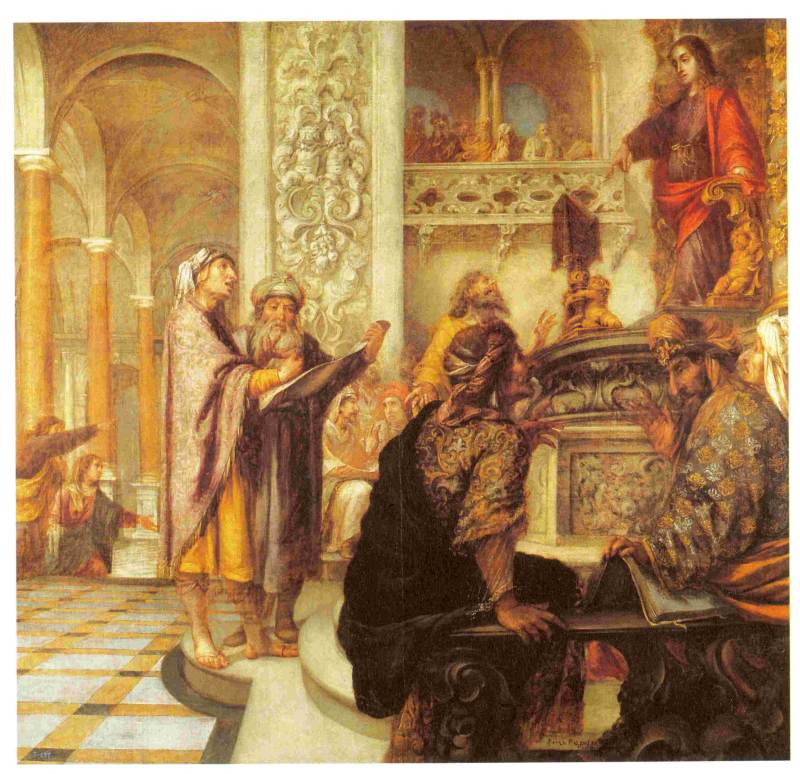 , Jesus is presented as a ruler on a high throne teaching those around him. In a similar way, rising above those surrounding him, Christ is depicted in the old painting by Veronese, see fig.2.21
, Jesus is presented as a ruler on a high throne teaching those around him. In a similar way, rising above those surrounding him, Christ is depicted in the old painting by Veronese, see fig.2.21 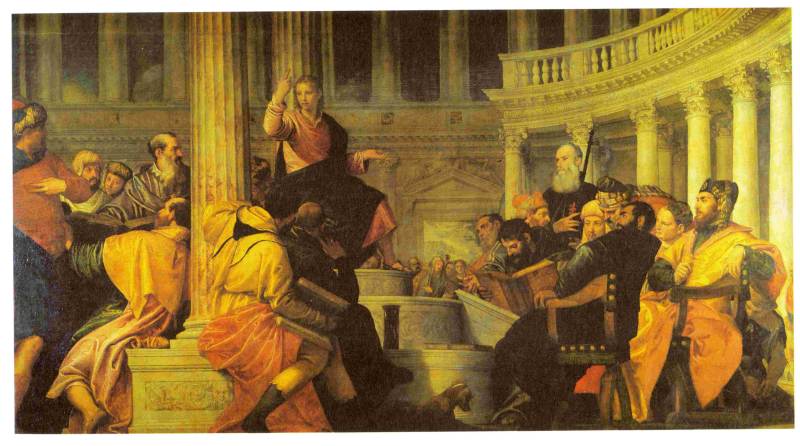 .
.
12. THE FALL OF THE TOWER IN SILOAM DURING THE TIMES OF CHRIST.
In one of his sermons Christ mentions some sad event which was presumably contemporary to him. In Jerusalem a tower collapsed and crushed eighteen people. ‘Or those eighteen on whom the tower in Siloam fell and killed them: do you think that they were worse offenders than all the others who lived in Jerusalem?’ (Luke 13:4).
Nichetas Choniates gives us the following account. After becoming a king ‘Andronicus took up entertainments… One time a number of banisters next to the imperial throne collapsed and crushed about six people. There was a terrible commotion among the audience present at the theatre on that occasion’ [140], p.300-301. Choniates dedicates an entire half a page to this event.
In the following chapter 3 we will show that in the Russian history Christ was reflected as the Grand Prince Andrei Bogolyubsky. So it makes one think that the ‘collapsing of a tower’ could have also been described in the Russian chronicles. Our prognosis comes true. We cite: ‘Loving Vladimir on Klyazma like a father… Andrei also cared for its residents with the same attention and affection; in the streets there were the horse-drawn carts continuously taking food to the sick and the poor sent by the prince. Having built the Golden gates after a fashion of those in Kiev, he wished to make a surprise by unveiling them for the festivity of the Assumption of the Mother of God. But the mortar did not dry and harden in time for the celebration and when the folk gathered the GATES COLLAPSED AND BURIED 12 SPECTATORS. Then Andrei prayed to the miracle-working icon with all his heart: ‘If you don’t save these people, than I, sinful man, will be guilty of their death!’ They lifted the gates and all the people crushed underneath had remained safe and sound’. [101], book 2, p.491. It is quite possible that the Gospel tower in SILOAM and the GOLDEN gates is the same thing. In fig.2.22 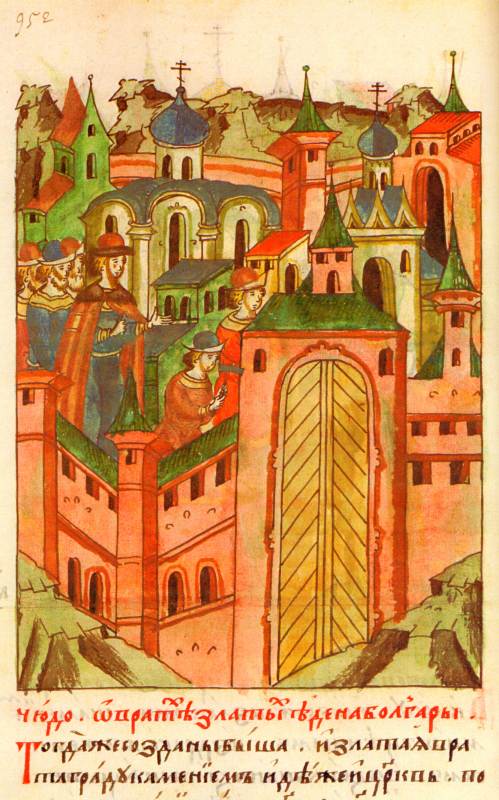 we present an old miniature painting from the ‘Tsarstvenny Letopisets’ (‘Royal Chronicle’ – Tr.) depicting the collapse of the gates in the times of Andrei Bogolyubsky and a miraculous salvation of the 12 people buried underneath. Incidentally, the ‘gates’ in the miniature picture look exactly like a falling tower, which is specifically mentioned in the Gospels. Incidentally, the Gospels speak of the eighteen people under the ruins, the Russian story - of twelve and in Andronicus’ biography – of six. Though the numbers differ, their order generally speaking is the same. By the way it is also possible that the name SILOAM originated from the Slavic word ZOLOTOI (golden – Tr.) when Z transferred into S (Z à S) and Russian ‘t’ (handwritten ‘mэ’ with three vertical lines) into Latin ‘m’ (mэàm) ‘. Please see the examples of such transitions in our linguistic Dictionary of Parallelisms in CHRON7.
we present an old miniature painting from the ‘Tsarstvenny Letopisets’ (‘Royal Chronicle’ – Tr.) depicting the collapse of the gates in the times of Andrei Bogolyubsky and a miraculous salvation of the 12 people buried underneath. Incidentally, the ‘gates’ in the miniature picture look exactly like a falling tower, which is specifically mentioned in the Gospels. Incidentally, the Gospels speak of the eighteen people under the ruins, the Russian story - of twelve and in Andronicus’ biography – of six. Though the numbers differ, their order generally speaking is the same. By the way it is also possible that the name SILOAM originated from the Slavic word ZOLOTOI (golden – Tr.) when Z transferred into S (Z à S) and Russian ‘t’ (handwritten ‘mэ’ with three vertical lines) into Latin ‘m’ (mэàm) ‘. Please see the examples of such transitions in our linguistic Dictionary of Parallelisms in CHRON7.
13. THE LEGEND OF THE GOLDEN AGE AS A VAGUE MEMORY OF CHRIST’S RULING.
In the mythology of various peoples for a long time there was held an idea about some Golden age, see fig.2.23 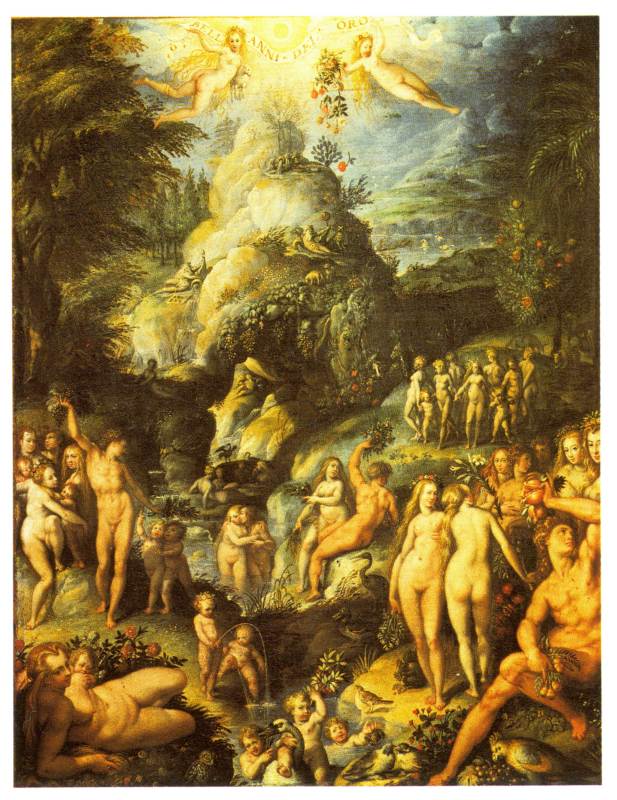 . It is thought that it was a very long time ago and was accompanied by good plentiful harvests. We’ll cite: ‘According to Hesiod the first mortals lived at their pleasure under the ruling of the supreme god Cronos. ‘Godlike, they lived like gods… the grain-growing earth bore fruit without tilling’… The Roman poet Ovid paints a similar picture of the Golden age... ‘Then the untilled earth gave of its produce and, without needing renewal, the fields whitened with heavy ears of corn. Sometimes rivers of milk flowed... and golden honey trickled from the green holm oak’ [95], v.1, p.471.
. It is thought that it was a very long time ago and was accompanied by good plentiful harvests. We’ll cite: ‘According to Hesiod the first mortals lived at their pleasure under the ruling of the supreme god Cronos. ‘Godlike, they lived like gods… the grain-growing earth bore fruit without tilling’… The Roman poet Ovid paints a similar picture of the Golden age... ‘Then the untilled earth gave of its produce and, without needing renewal, the fields whitened with heavy ears of corn. Sometimes rivers of milk flowed... and golden honey trickled from the green holm oak’ [95], v.1, p.471.
Nicetas Choniates describes the reign of Andronicus with very similar words. He informs us that since Andronicus eliminated bribery as a result ‘over a short amount of time the population of the cities increased, the land reaped a fruitful harvest many time over, the living became cheaper’ [140], p.338-339. Choniates praises highly and in detail the practices which were then established. Though, we will repeat it once again, he is not fond of Andronicus.
Moreover Nicetas Choniates writes directly that the citizens of Czar-Grad summoning Andronicus to the city, thought his reign as the GOLDEN Age or as the FEAST OF THE SUN [140], p. 262-263. We cite: ‘Arriving in crowds to Andronicus they … were intoxicated by the honeyed speech… and returned extremely delighted as if they had discovered the CELEBRATED GOLDEN AGE… OR WERE SATIATED BY THE SO CALLED FEAST OF THE SUN’ [140], p.262-263. Here besides the Golden Age we can see the identification of Andronicus with the SUN. It was specifically the reign of Andronicus which according to the words of Nicetas Choniates was called THE FEAST OF THE SUN. But the Sun is a well-known symbol of Christ. We often come across the expression Christ-Sun on the pages of the old Christian manuscripts.
There occurs a natural hypothesis about the origins of a myth of the Golden age. It seems to have already appeared in the epoch of Christianity as a recollection of the reign of Christ himself. The expression "лето Господне приятно"(the Lord’s year/summer pleasing ?)traditional in Christian literature possibly speaks of it as well denoting the time of Christ’s service before his crucifixion [20], v.1, p.91. We are now starting to understand that the gospel ‘service’ of Christ is the time of his reign. It was, quite clearly, ‘pleasing for the Lord’, i.e. to Christ. The memory of him in the folk tales turned into a legend of the Golden age. It is possible that something of the kind was also in the text which Choniates was editing. It was probably described in such a dramatic way that Nicetas Choniates kept this extract despite his negative attitude towards Andronicus.
In chapter 5 we will show that the ‘Ancient’-Egyptian god Osiris is a reflection of Jesus Christ. In this regard we should note the belief of the Egyptian myths that under Osiris there prevailed the Golden Age in Egypt. The Egyptologists have long ago turned their attention to a legend of ‘Osiris’ reign on Earth as a kind master under whom Egypt experienced its ‘GOLDEN AGE’ ‘[86], p.45.
14. ANDRONICUS WITH A SCYTHE IN HIS HANDS.
Nicetas Choniates reports the following about Andronicus: ‘On the outside, close to the North gates of the temple looking onto the square, he depicted himself in an epic painting not in the royal attire and not in the golden imperial garment, but as a poor farmer in blue coloured clothes hanging down to his waist, and in knee high white boots. IN HIS HAND THIS FARMER HAD A LARGE, HEAVY AND CURVED SCYTHE’ [140], p.340. Besides, from ‘Historia’ by Nicetas Choniates we can conclude that they called Andronicus A SICKLE BEARER. Specifically: ‘Many think this ancient prophecy refers to him (i.e. to Andronicus – Author): ‘SICKLE BEARER, the four months await you’’ [140], p.359. A sickle, as well as a scythe, is meant for cutting grass and harvest grain cereals.
But we have already seen that the date of the crucifixion of Andronicus-Christ (specifically year 1185) is depicted on the famous Circular Dendera Zodiac or as it is also called Osiris Zodiac. But then it immediately strikes you that in this Egyptian Zodiac (and only in it!) there is depicted a MAN WITH A SCYTHE IN HIS HANDS, see fig.1.32 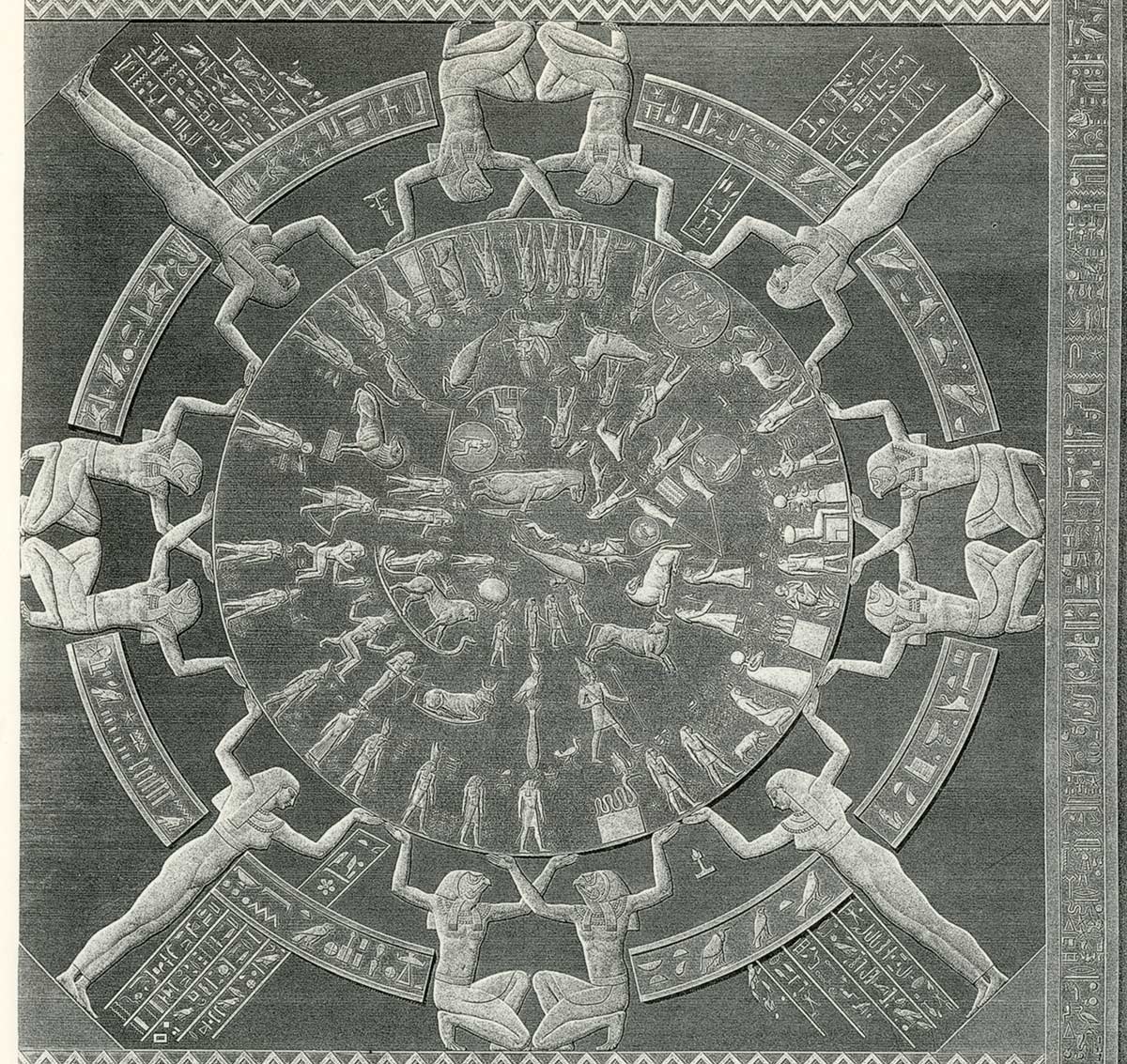 and fig.2.24
and fig.2.24  . It is Saturn holding a scythe in his hands in a private horoscope of the autumnal equinox. See the details in [MET3]:4 and CHRON3, ch.13.
. It is Saturn holding a scythe in his hands in a private horoscope of the autumnal equinox. See the details in [MET3]:4 and CHRON3, ch.13.
However there is no other Byzantine emperor depicted in an ‘epic painting’ with a scythe in his hands.
15. THE ENORMOUS HEIGHT OF THE EMPEROR ANDRONICUS AND THE SHROUD OF CHRIST.
We have already mentioned above that the height of Christ measured according to the Shroud equals to 175-180 centimetres. Which is for the Middle Ages and even for the modern age quite tall. Such a man should have been considered quite tall, ‘enormous’. Does it correspond to the description of Andronicus? Yes, it dose, and perfectly.
Earlier we have quoted Nicetas Choniates: ‘Andronicus stretched on the floor at the full length of HIS ENORMOUS HEIGHT’ [140], p.241-242. There is a number of similar testimonials on the pages of ‘Historia’ by Choniates.
Moreover, according to Choniates, the enemies of Andronicus called him a CYCLOPS [140], p.279. I.e. a single eyed giant. Thus, for example, the conspirators ‘considering such actions of Andronicus to be repugnant and clearly referring to the CYCLOPS’ FEAST …agreed that… would never let their eyes rest … until Andronicus was put to death’ [140], p.279. We will remind you here that after Andronicus was arrested his left eye was put out.
And further: ‘He was lying stretched at the full length of HIS ENORMOUS HEIGHT’ ‘140], P.266.
And also: ‘THEY WERE ASTONISHED BY HIS HEIGHT [140], p.262.
And more: ‘He was straight in posture, MAJESTICALLY TALL, his face even until his old age was youthful-looking’ [140], p.359.